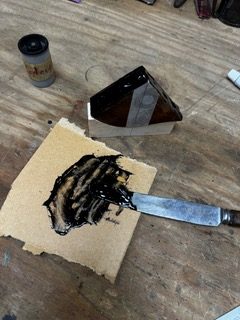A Gluing Challenge

Today’s challenge has been how we might glue a broken foot of an arts and crafts bureau dating from the early 1900s. The two main difficulties that we will have to sort out is that break has previously been glued unsuccessfully and the shapes involved are difficult to clamp.
We start with cleaning the old adhesives off the parts. There is evidence of at least two different glues having been used. The parts are cleaned with boiling water and by mechanically scraping off that which does not clean with the water.

When the parts have been cleaned as best we can, being mindful that too much cleaning will remove wood and then the parts will not fit particularly well, we drill a series of depressions on the faces to be glued which will increase the gluing surface area.

We will be using epoxy resin coloured with Black powder. If we were to use almost any glue in its ‘ natural ‘ state the glue line will almost invariably show as an off white colour. What we are aiming to do is fool the eye by making the glue line Black which will be a closer match to the grain lines of the wood being repaired .
Because of the awkward shapes of the parts, we will have difficulty clamping them. Trying to apply clamps in a conventional manner the clamp will just slip off. To prevent the clamp slipping off, we make ourselves a clamping caul. A caul is simply a shaped piece of wood that will help us apply pressure in a manner that a clamp alone cannot do. The following photo shows that we have used two cauls. Caul A has been fabricated from timber offcuts whereas caul B has been cut to fit.

Though you can still see the glue line, it is less obvious than the off-white colour of a conventional glue line. We will do some finishing work on this to blend it in for a closer match to the rest of the piece.